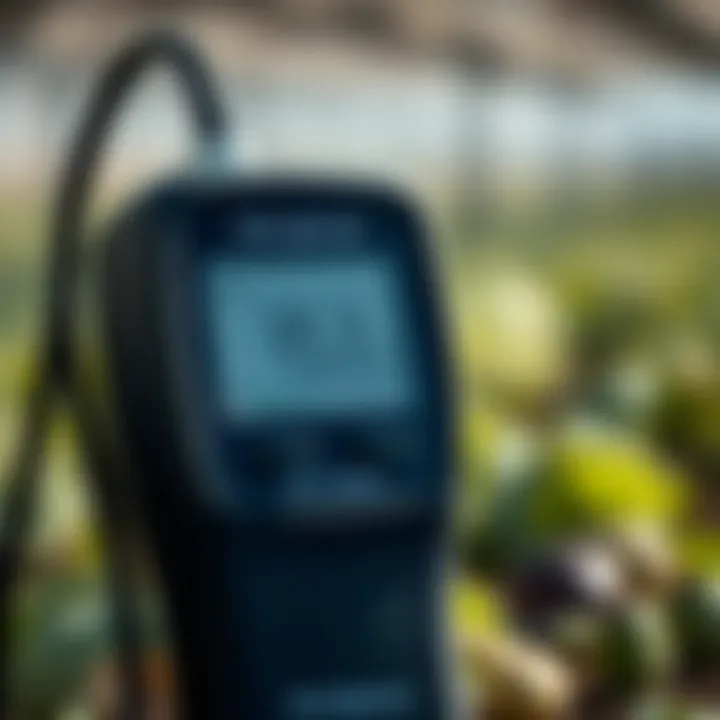The Best pH Meters: A Comprehensive Guide


Intro
Understanding soil and water pH is fundamental for anyone involved in agriculture, horticulture, or agronomy. The pH level significantly influences plant nutrition, affecting both growth and yield. This guide dives deep into the realms of pH meters, illuminating their crucial role in managing soil and water quality, which ultimately leads to healthier plants and better harvests. The following sections will unpack various types of pH meters, essential features for selection, and maintenance tips that can extend the instrument's lifespan. Let’s explore this vital topic, tailored for both professionals and enthusiastic gardeners, aiming for optimal plant health.
Prolusion to pH Meters
In the realm of agriculture and horticulture, the pH meter stands out as an essential tool for growers aiming to optimize soil and water quality. Understanding how pH affects plant health is crucial for anyone involved in these fields, and a pH meter plays a vital role in that process.
Why pH Matters
At its core, pH serves as a measure of acidity or alkalinity, a factor that significantly influences nutrient availability in soil. Knowing the pH level of your soil can affect decisions around fertilization, crop selection, and broader agricultural practices. Therefore, having access to a quality pH meter can mean the difference between a bountiful harvest and a disappointing yield.
Understanding pH and Its Importance
Before delving into the specifics of pH meters, it helps to grasp what pH actually is and why it’s so important for the agricultural landscape.
pH is measured on a scale from 0 to 14, with lower numbers indicating acidity and higher numbers signaling alkalinity. Water, with a neutral pH of 7, is essential for life. However, most plants thrive in a specific pH range—typically between 6 and 7.5. Outside of this range, the availability of vital nutrients fluctuates. For instance, if the pH dips below 6, nutrient lockout can occur, meaning that even if the soil contains necessary elements, the plants won't be able to absorb them.
- Impacts on Nutrients:
- Nitrogen is best absorbed around pH 6.5.
- Iron becomes unavailable in alkaline conditions.
- Phosphorus is more soluble at neutral pH.
Understanding these dynamics reshapes how one approaches fertilization and amendments, making them far more effective. Whether you’re a small hobby gardener or managing acres of farmland, knowledge of pH can shape your success.
How pH Affects Plant Growth
The relationship between pH and plant growth is fundamentally tied to the nutrient uptake capabilities of plants. Imagine it this way: each breed of plant has its preferences, much like how someone might favor sweet tea over the bitterness of coffee. When a plant's surrounding environment is tailored to its preferences, growth is robust; when it's not, problems arise.
Different crops have varying pH needs. For instance, blueberries prefer more acidic soils, whereas asparagus thrives in slightly alkaline conditions.
"Healthy plants stem from healthy soil, and understanding pH is the key to fine-tuning that relationship."
Take a moment to think about the implications of an incorrect pH. Stunted growth, increased susceptibility to diseases, and reduced yields can all stem from neglecting this critical factor. A simple yet effective way to mitigate these risks is by regularly monitoring pH levels with a reliable pH meter.
In summary, starting with an understanding of pH and its critical role sets the tone for realizing the potential of crops. A pH meter should not only be viewed as a tool but as an indispensable guide in cultivating healthy plants and maximizing agricultural output. Armed with this knowledge, growers can make informed choices for their fields, leading ultimately to sustainable practices that benefit both the earth and the harvest.
Types of pH Meters
Understanding the different types of pH meters is vital for anyone looking to monitor soil or water acidity effectively. Each type serves specific purposes and has distinct advantages and limitations. Selecting the right pH meter can make a big difference in gardening, farming, or even research projects. By knowing your options, you can better suit the meter to your needs, whether you're doing a quick soil test in the backyard or conducting extensive agricultural studies.
Portable vs. Bench Meters
When considering pH meters, one of the first decisions lies between portable and bench models. Portable pH meters are designed for convenience. They are lightweight, easy to carry, and often battery-operated, making them suitable for fieldwork. They're invaluable for farmers who need to test soil in different plots or water sources. Being able to move around and take quick readings allows for rapid adjustments in practices.
Bench meters, on the other hand, are the workhorses for laboratories or fixed settings. These meters offer greater precision and usually come with enhanced features. They are better for detailed analysis, providing readings that are often more stable and reliable, especially for long-term experiments or ongoing monitoring.
Key Differences:
- Portability: Easy to carry versus fixed location.
- Precision: Bench meters tend to be more accurate and stable.
- Applications: Portable for fieldwork, bench for lab settings.
Analog vs. Digital Meters
The choice between analog and digital pH meters hinges on user preference and specific needs. Analog meters show readouts using a dial and a needle, which can be satisfying for those who appreciate traditional tools. They don’t require batteries, making them reliable in emergency situations. Nonetheless, they also tend to be less user-friendly, as interpreting the needle position can sometimes be tricky.
Digital meters, however, have become the standard for most due to their ease of use. They provide clear, numerical readouts and often come with automatic temperature compensation, which enhances reliability. Digital meters can also include features such as data logging, making it easier to track changes over time.
Highlights:
- Ease of Use: Digital meters often win for simplicity.
- Features: Digital has additional functionalities like logging.
- Maintenance: Analog meters are simpler but may not be as precise.
Soil pH Meters vs. Water pH Meters
This distinction is crucial, especially when it comes to specific application areas. Soil pH meters are specifically designed to penetrate soil and provide readings based on soil composition. They often feature a longer probe to reach beneath the surface.
On the flip side, water pH meters are fine-tuned for liquids, offering better sensitivity in that medium. These meters usually come with a shorter, delicate probe that wouldn't work well in soil due to possible damage or inaccurate readings.
Considerations for Each Type:
- Soil Meters: Designed for density and composition of soil.
- Water Meters: Built for sensitivity and speed.
- Usage: Choose a meter based on your primary testing medium.
Key Features to Consider
When choosing a pH meter, discerning farmers and horticulture enthusiasts must look beyond mere prices and brands. The selection of a pH meter hinges on several pivotal features that drastically affect its utility and longevity. Understanding these key features—such as calibration options, accuracy and range, durability, display functionality, as well as price considerations—can make a substantial difference in soil and water management efforts. Here, we dive into these essential elements to empower informed decisions in your agricultural pursuits.
Calibration Options


Calibration sits at the heart of a pH meter’s efficacy, ensuring accurate readings over time. The basic premise is that a meter needs to be calibrated against solutions of known pH values to provide reliable measurements in the field.
Many meters offer either one-point or multi-point calibration—where multi-point adds versatility in various environments. Utilizing a multi-point calibration can extend the accuracy, especially for complicated sampling terrains or diverse crop types. It is generally recommended to calibrate the device before each use for precision, particularly when dealing with sensitive plants.
- User-Friendly Calibration: Look for meters that allow for easy adjustments, typically with simple push-button mechanics.
- Buffer Solutions: Make sure the pH meter package includes calibration solutions for a better start and maintain some handy in your tackle box.
Accuracy and Range
A pH meter’s accuracy and range are crucial. If your meter is inaccurate, it's like throwing darts blindfolded; you might hit the target, but chances are slim. The accuracy of 0.01 pH units is usually preferred for precision agriculture.
It's also essential to consider the pH range. Most agricultural applications fall in the range of 4.0 - 9.0, but having a meter that can measure from 0-14 can be advantageous, especially if you work with a variety of substrates. Insights into both your soil and water quality hinge on these precision metrics.
- Check Calibration Reports: Some high-end models provide historical calibration reports, which can come in handy for future reference.
- Range Suitability: Ensure the selected meter’s range aligns with the crops you’re managing.
Durability and Build Quality
Agriculture isn't a neat and tidy profession; rugged conditions can present challenges to even the highest quality equipment. The durability of your pH meter shouldn’t be overlooked. Make sure it has a sturdy, water-resistant body, and consider whether it has been designed for outdoor usage.
Meters with ruggedized designs often resist shocks and temperature fluctuations, both of which are commonplace in agricultural settings. To safeguard your investment, read product reviews to gauge how other users perceive the build quality.
- Submersible Designs: Some models are specifically designed to withstand harsh environmental conditions.
- Warranty Considerations: A solid warranty can often provide assurance regarding the longevity of your investment.
Display Features
The way data is presented can make a world of difference when you're on-site trying to make quick decisions. Digital pH meters usually feature LCD screens, which provide a clear read-out of pH levels. Some models even include backlit displays for better visibility in low-light situations like early mornings or dusky evenings.
- Auto-Off Function: Look for meters equipped with this function to conserve battery life during extended use.
- Data Hold Function: This feature lets you freeze a reading on the display, which can be extremely useful when you’re busy jotting down notes or referencing other parameters.
Price and Budget Considerations
At the end of the day, your budget may dictate a lot of your choices when it comes to selecting a pH meter. Premium models loaded with features are tempting but might not suit every pocket. The reality is you can find reliable pH meters in various price ranges, but striking a balance between cost and features is essential.
Consider the following:
- Long-Term Investment: Cheaper meters might require frequent replacements, where a higher-quality meter could save money over time.
- Feature Necessity: Assess which features are essential for your needs before splurging on unnecessary bells and whistles.
Ultimately, every feature you consider should align with your specific pH testing needs, whether for soil, water quality, or plant management. With all these points taken into account, you'll be well-equipped to choose a pH meter that will serve you faithfully.
Top pH Meters on the Market
When it comes to measuring pH, having a solid meter can be the difference between success and failure in various growing conditions. pH meters have become indispensable tools for agriculture, horticulture, and similar fields, ensuring that plants receive the right balance of nutrients and thrive in a healthy environment. In this section, we delve into the top pH meters available on the market today, highlighting their unique features, advantages, and considerations that cater to the needs of both amateurs and seasoned professionals alike.
High-End Options
For those who are serious about their craft, investing in a high-end pH meter is a wise choice. These meters often come packed with features designed for maximum precision and versatility. Brands such as Hanna Instruments and Oakton have models tailored for volume access, rapid temperature compensation, and data logging capabilities.
- Hanna HI98194: This model excels in accuracy and includes capabilities for temperature measurement alongside pH levels. Its waterproof design and rugged build make it perfect for fieldwork, ensuring reliability in any weather conditions.
- Oakton pH 5+: Another highly-rated choice, it offers a large display for easy readability and features automatic calibration for effortless adjustments.
These premium meters are suitable for users looking for long-lasting and reliable instruments, despite a higher price tag.
Mid-Range Choices
If you're not looking to break the bank but still crave precision, there are several commendable mid-range options. These pH meters generally provide decent accuracy without all the bells and whistles of high-end models. Consider the Milwaukee MW101 for its ease of use; it features a straightforward interface with good reliability. Another solid pick is the Apera Instruments P0. It has a replaceable electrode, meaning you won't have to toss the entire unit after prolonged use.
Features to look out for in this category include:
- Decent calibration capability with a reasonable level of accuracy
- Good battery life and user-friendly interfaces
- A balance between cost and essential features
These mid-range pH meters can yield excellent results for growers who want to monitor their soil or water quality without going overboard on expense.
Budget-Friendly Alternatives
For hobbyists or those testing pH on a less regular basis, budget-friendly options provide great value. Models like the Bluelab pH Pen and Vivosun Soil pH Meter are economical choices that deliver satisfactory results for non-professionals.
- Bluelab pH Pen: Renowned for its portability and straightforward operation, it allows users to check their nutrient solutions without breaking the bank.
- Vivosun Soil pH Meter: This inexpensive meter works well in the garden, allowing for quick checks without a steep learning curve.
While these devices may lack the sophistication of higher-end models, they serve well for casual users and beginners. Keep in mind their limited durability; they often need frequent monitoring and possibly replacement after extended use.
"Quality pH meters are investments that can not only enhance plant health but also boost overall yield. Ensuring you choose a model that aligns with your needs will pay dividends in the long run."
In selecting the right pH meter, consider your usage patterns, budget, and the specific requirements of your plants. Each tier of pH meter has something to offer, whether you're measuring water solutions for hydroponics or checking the soil conditions for your vegetable garden.
Using a pH Meter: Procedure and Best Practices


Utilizing a pH meter effectively is key in ensuring accurate soil and water readings. This task can seem daunting, but the benefits of mastering it are significant. Not only does proper use aid in selecting the ideal pH meter, but it also plays a vital role in testing soil health, guiding fertilization, and ultimately boosting plant growth and yield. Let’s look at the steps and best practices you should follow to get reliable readings from your pH meter.
Preparation before Measurement
Preparation is half the battle won when it comes to using a pH meter. Before you dive in, consider these considerations:
- Select the Right Meter: Ensure that your pH meter is suitable for the specific medium you’ll be testing—be it soil or water. Different meters are designed for different environments.
- Calibration: Before taking any readings, you must calibrate your pH meter. This involves using standard buffer solutions at known pH values, ensuring that the meter provides accurate results. A well-calibrated meter is akin to a well-tuned instrument; without it, the output can be off-key.
- Preparation of Samples: If measuring soil pH, it’s crucial to collect samples consistently. Remove debris and organic matter, taking care to gather soil from various depths to ensure a representative sample.
As the old saying goes, "Failing to prepare is preparing to fail." Taking these preparatory steps helps ensure that your measurements are both meaningful and useful.
Step-by-Step Measuring Technique
Once you’ve prepped everything, it’s time for the measuring. Here’s a clear-cut way to achieve optimal readings:
- Rinse the Electrode: Before measuring, rinse the electrode of your pH meter with distilled water to remove any contaminants.
- Insert the Electrode: Place the electrode into the sample. Make sure it is submerged properly, especially for soil mixtures where a slurry might be needed.
- Wait for Stability: Allow some time for the reading to stabilize on the display. Depending on your meter, it could take several seconds.
- Record the Reading: Once the reading has leveled off, jot it down. It’s a good idea to take multiple readings and average them for the most reliable data.
Following these steps aids in achieving an accurate pH measurement. If not done correctly, the results might lead you astray, giving you a value that’s as good as useless.
Interpreting Results
After gathering your measurements, understanding them is crucial. An accurate pH reading alone won't suffice if you don't know its implications. Here’s how to navigate that:
- Know the Range: The typical pH level for most plants lies between 6.0 and 7.0. Below that, it’s acidic; above that, it’s alkaline. Too far from this range can hinder nutrient uptake in plants.
- Consider Context: A reading in isolation might not tell you much. Try to correlate it with other measurements, such as soil texture, moisture, and specific crop needs.
- Taking Action: If the pH is off, act accordingly. This could mean amending the soil with lime to increase pH or sulfur to decrease it. Make sure to document any changes and re-test periodically to monitor effectiveness.
"A pH reading is merely a number unless you understand its significance in the context of your environment."
All in all, using a pH meter correctly involves preparation, careful measurement, and informed interpretation of the results. With practice, these steps become second nature and lead to better outcomes in your agricultural pursuits.
Maintenance and Calibration of pH Meters
Maintaining the accuracy of a pH meter is not merely a good practice; it's a necessity. A poorly calibrated meter can yield misleading results, affecting everything from soil health to crop yield. Regular maintenance encompasses not only calibration but also cleaning and proper storage. Each of these aspects plays a significant role in prolonging the life of the meter and ensuring it provides reliable readings when you need them most.
Importance of Regular Calibration
Calibration acts as the backbone of pH meter performance. It ensures that the device has a proper reference point against which to gauge pH levels. Here's why calibration should be a non-negotiable part of your routine:
- Accuracy: Regular calibration adjusts for drift in the sensor's readings over time. Environmental factors such as temperature, humidity, and even the age of the electrode can affect accuracy and lead to inconsistent results. By calibrating at set intervals, you can keep your measurements as true-to-life as possible.
- Standardization: Calibration involves using standard buffer solutions. This not only checks the meter's performance but also creates a consistent baseline for your measurements. Whether you're in the field or at the lab, being able to trust your readings means everything.
- Avoid costly mistakes: The repercussions of relying on faulty data can be severe, impacting plant health and, ultimately, your bottom line. Ensuring your meter is calibrated regularly can save you from costly errors in treatment or crop management.
Cleaning Techniques
A pH meter is not just a tool but an investment in your agricultural success. Keeping it clean is pivotal for prolonging its lifespan and accuracy:
- Rinse with Distilled Water: After each use, it’s best to rinse the electrode in distilled water to remove any residue from the solutions tested. Tap water can leave mineral deposits that affect readings.
- Use a Soft Brush: For stubborn dirt or contamination, gently using a soft brush can help. Just be cautious; the electrode is delicate, so pressure should be applied sparingly.
- Soak If Necessary: Occasionally, it may be beneficial to soak the electrode in specific cleaning solutions available in the market. Following manufacturer directions is crucial, as prolonged exposure to certain chemicals can damage the electrode.
Storage Recommendations
How you store your pH meter has a significant impact on its performance and longevity. Here are key practices:
- Use Storage Solutions: Most pH meters should be stored with the electrode immersed in a storage solution recommended by the manufacturer. This keeps the electrode moist, which helps maintain its performance.
- Avoid Extreme Temperatures: Make sure to store meters in a moderate environment, avoiding extreme hot or cold temperatures. Fluctuations can impair the function of the sensor and electronics.
- Store Upright: When not in use, it's advisable to store the pH meter upright. This prevents any solution from leaking into the device itself, which could result in malfunction.
By adhering to these maintenance and calibration guidelines, you'll ensure that your pH meter is always ready to provide accurate readings, enhancing your management practices in agriculture and horticulture.
Common Issues with pH Meters
Using a pH meter can be a game changer in achieving optimal plant health and yield. However, it's not all sunshine and rainbows. Just like any piece of equipment, pH meters come with their own set of challenges that can lead to inaccurate readings or equipment failure. Understanding these common problems can save users time, money, and hassle down the road.
Troubleshooting Calibration Errors
Calibration errors are one of the most frequent issues encountered when using pH meters. A pH meter needs to be calibrated regularly to ensure accurate readings. If you find your pH readings are inconsistent or seem off, here’re a few steps to troubleshoot calibration errors:
- Check Calibration Standards: Ensure that you're using the correct calibration solutions. Old or improperly stored calibration solutions can alter the pH readings.
- Frequency of Calibration: Depending on usage, calibrate your meter before each use or at least once a day for heavy users. If there’s a significant temperature difference between the calibration solution and your sample, it might skew results.
- Two-Point Calibration: If your pH meter allows for it, using a two-point calibration can enhance accuracy. This involves calibrating with a solution that has a known pH below 7 and one above.
- Meter Condition: Inspect the electrode for any signs of damage or degradation. A worn out electrode can cause unreliable readings and may need replacement.
Addressing calibration issues promptly is vital. A small oversight can lead to larger issues in plant health if not rectified.
Handling Performance Drop-offs
Performance drop-offs are another headache that can crop up when using pH meters. Over time, a pH meter may show a decline in accuracy or responsiveness, and recognizing this can make a world of difference in your results. Here are some steps to take if you notice your meter isn't performing up to par:
- Evaluate Electrode Status: The electrode is the heart of a pH meter. If readings fluctuate wildly, check the electrode to see if it’s dirty or needs replacing.
- Storage Conditions: Improper storage can lead to performance issues. Always store electrodes in a suitable storage solution to keep them saturated.
- Temperature Compensations: Ensure that you’re accounting for temperature variations. Some pH meters come with automatic temperature compensation, while others do not.
- Regular Maintenance: A little preventive care can go a long way. Clean your meter and electrode regularly, following the manufacturer's guidelines.
Remember, neglected maintenance can lead to more significant issues down the line. Early detection and timely action are key to keeping your pH meter humming smoothly.
Comparative Analysis: pH Meters vs. Other Testing Methods


Understanding the Landscape
When it comes to gauging the acidity or alkalinity of soils and liquids, pH meters are often seen as the gold standard in precision and reliability. However, savvy farmers and horticulturists frequently find themselves weighing the benefits of pH meters against other methods, such as test strips and colorimetric testing. This section delves into these alternatives, highlighting their strengths and weaknesses, and clarifying when one might be preferable over the other.
The right tool for the job can make all the difference in the world of agriculture.
Test Strips
Test strips offer a straightforward, user-friendly option for checking pH levels. They come coated with pH-sensitive dyes that change color based on the acidity of the solution in contact with them. It's as easy as dipping a strip into the substance and comparing the resulting hue against a provided scale. Here are some key points about test strips:
- Pros:
- Cons:
- Affordability: They’re typically less expensive than digital pH meters.
- Portability: There’s no need for batteries or complex setups.
- Immediate Results: They provide quick feedback, useful for on-the-spot checks.
- Accuracy Limitations: While they give a general idea, they may not be as precise as a pH meter, especially for scientific applications or where tiny pH shifts matter.
- Single Use: They're often not reusable, leading to more waste.
For hobbyists or those new to pH measurement, test strips can serve as a nice introduction. However, for serious groundwater analysis or precision-based agriculture, their utility may fall short.
Colorimetric Testing
Colorimetric testing takes an approach similar to test strips, although it generally combines a reagent with a sample solution. Users add a chemical solution to the liquid being tested, and a change in color provides an approximate pH reading. This method is notably favored in research settings due to its graphical representation of pH changes.
- Pros:
- Cons:
- Greater Precision: Colorimetric tests can offer better accuracy than test strips, especially when used with suitable equipment.
- Detailed Analysis: The process can pinpoint changes in pH more dynamically than simple strips.
- Complexity: It requires a bit more know-how and does involve more steps compared to both pH meters and test strips.
- Time-Consuming: Results may not be as immediate, needing time for chemical reactions to occur fully.
For professionals or anyone who needs a deeper analysis of their soil or water quality, colorimetric testing presents a viable option, particularly in lab settings.
The End of Analysis
In summary, while pH meters consistently provide robust accuracy and reliability, each alternative — test strips and colorimetric testing — brings unique benefits and considerations. The choice often boils down to the specific context and requirements of the user.
For those involved in sustainable and effective farming or gardening, understanding the advantages and limitations of these different testing methods plays a crucial role in achieving their agricultural goals.
The Role of pH Meters in Sustainable Agriculture
In the realm of modern agriculture, understanding the delicate balance of soil chemistry becomes increasingly vital. pH meters play a pivotal role in managing soil health, which is foundational to sustainable farming practices. This significance cannot be overstated, as the right pH levels can dictate how effectively plants absorb nutrients, and ultimately, influence their growth and health. Let's delve into how these meters act as indispensable tools for farmers and enthusiasts alike, ensuring optimal crop yields and better environmental stewardship.
Monitoring Soil Health
Monitoring the health of soil is crucial for both new gardeners and seasoned farmers. A pH meter provides a straightforward method for determining the acidity or alkalinity of the soil. With a simple measurement, you can gauge whether the soil condition is conducive to plant growth.
- For instance, most crops thrive in a pH range between 6.0 and 7.5. If the pH falls below 6.0, it may indicate excessive acidity, which can hinder nutrient uptake.
- Conversely, soils with a pH above 7.5 can lead to alkalinity, often resulting in nutrient deficiencies as well.
By regularly monitoring soil pH, farmers can:
- Adjust soil amendments accordingly, using lime to raise pH or sulfur to lower it.
- Identify potential issues early, preventing crop damage and reducing the need for expensive corrective measures later on.
- Foster biodiversity within the soil ecosystem by maintaining optimal pH levels for various organisms essential for nutrient cycling.
“A well-maintained pH can be the difference between a struggling crop and a flourishing one.”
Getting into a habit of checking soil pH at different growth stages can truly set growers apart. It allows for informed decisions on fertilization, irrigation practices, and even which crops to plant based on the specific needs of the soil.
Impact on Crop Yield
The pH of the soil doesn’t just influence nutrient uptake; it has a direct correlation with crop yields. When soil pH is in the optimal range, crops can efficiently access the necessary nutrients. The compromise of this natural balance can lead to poor growth, reduced fruiting, and even crop failure.
Several points illustrate why pH meters matter when it comes to crop yield:
- Nutrient Availability: Certain nutrients become less available if pH is too high or too low. For example, iron becomes less available in alkaline conditions, which can lead to deficiencies in crops like soybeans and tomatoes.
- Disease Resistance: Healthy plants that are in optimal pH conditions tend to be more resilient to pests and diseases. Stressed plants, on the other hand, drop in productivity.
- Enhanced Soil Structure: Correct pH is not only beneficial for plants but also for soil microbes and earthworms, which improve overall soil structure and fertility.
In summary, a reliable pH meter enables farmers to tailor their practices in a more targeted way. It equips them to adapt to changing soil conditions, ultimately enhancing sustainability efforts and ensuring that yields meet the growing demands of food security.
In essence, incorporating a pH meter into regular farming operations is an investment in the future of agriculture, aligning with the principles of sustainable land management and promoting healthier ecosystems.
Closure
The final section of this guide emphasizes the criticality of utilizing pH meters in agriculture and gardening. Everything from soil health to crop yield relies on the precise measurement of pH levels. It's like tuning an engine; without the right pH, your plants can't function to their best potential, leading to subpar growth. By keeping a close eye on pH levels, gardeners and farmers can make informed decisions that enhance their agricultural practices.
Summarizing Key Insights
To wrap everything up succinctly, here are some essential takeaways:
- Understanding pH is fundamental: It plays a vital role in nutrient availability for plants. An optimal pH range can greatly influence whether plants absorb essential minerals effectively.
- Choosing the right type of pH meter: Considerations, such as whether to go for portable or bench meters, depend on your specific needs. Each has its advantages that can cater to both casual and professional requirements.
- Maintaining accuracy: Regular calibration and proper cleaning are paramount to maintaining the reliability of your measurements. A pH meter can quickly lose its effectiveness if neglected, leading to misleading results.
- Future implications of pH measurement: With advancing technologies and methodologies, staying ahead in knowledge can make a substantial difference. Understanding new trends allows farmers and enthusiasts to adopt innovative practices that optimize crop yields.
Future Trends in pH Measurement
As technology progresses, we can expect several exciting developments in pH measuring devices and techniques.
- Smart pH Meters: Integration of IoT technology is likely to rise, making monitoring easier than ever. Imagine using an app on your phone to get real-time pH readings from your fields! This sort of technology will allow farmers to react promptly to pH fluctuations, which can optimize yields significantly.
- Machine Learning Applications: Data from pH meters may one day be analyzed using machine learning algorithms to predict trends and advise on the best practices based on historical data. This data-driven approach can greatly enhance decision-making processes.
- Eco-Friendly Options: As sustainability becomes a focal point in agriculture, we can expect pH meters that utilize eco-friendly materials and processes. This shift would not only help the environment but also appeal to the growing segment of eco-conscious consumers.
- Portable Technologies: Ongoing innovations will likely make portable meters more accessible and accurate. Farmers will be able to test multiple sites without the need for bulky equipment, making on-the-go measurements seamless.







